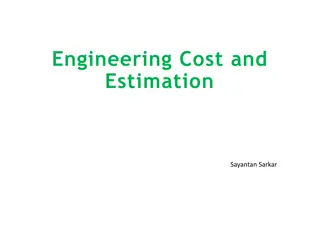Understanding Costs in Power Sector Decision-Making
Operational, decommissioning, and investment decisions in the power sector are influenced by different categories of costs. Operational decisions focus on variable costs like fuel and CO2 expenses, while decommissioning decisions consider both variable and fixed costs. Investment decisions require a comprehensive assessment of all costs to ensure profitability. This discussion provides insights into why specific cost categories are relevant to each type of decision-making.
Download Presentation

Please find below an Image/Link to download the presentation.
The content on the website is provided AS IS for your information and personal use only. It may not be sold, licensed, or shared on other websites without obtaining consent from the author. Download presentation by click this link. If you encounter any issues during the download, it is possible that the publisher has removed the file from their server.
E N D
Presentation Transcript
Integrated course Energy Economics - Electricity markets fundamentals - (continued) Chair of Energy Systems | Department of Energy Systems Technische Universit t Berlin
Task 2) Merit Order and Dispatch Decisions Expected Full Load Hours Capital Recovery Factor Emission Factor Investment Costs Fuel Price Capacity Efficiency Plant [ / [t CO2 / MWhth] [MW] [Million ] [%] [h] [-] MWhth] Nuclear Hard Coal Gas Turbine 900 1 665 36 11 8 000 0.08 - 0.342 750 750 46 20 4 500 0.08 0.198 250 100 36 25 2 000 0.09 a) Which categories of costs in the power sector are relevant i) for operational decisions ii) for decommissioning decisions and iii) for investment decisions? Explain why. i. Operational decisions should be made based on variable costs or, more specifically, marginal costs: fuel costs, CO2costs, variable O&M costs (costs denoted in /MWhel). Fixed costs are irrelevant for the operational decision, as the decision to produce has no influence on them (from a short-term perspective). If the market price is just higher than our variable costs, we should produce. We generate revenues, which both cover the variable costs and contribute to recovering our fixed costs (contribution margin). Slide 2
Task 2) Merit Order and Dispatch Decisions a) Which categories of costs in the power sector are relevant i) for operational decisions ii) for decommissioning decisions and iii) for investment decisions? Explain why. (continued) ii. Decisions with respect to decommissioning should not only consider variable costs, but also all fixed costs apart from the investment costs. As the investment costs cannot be influenced by the decommissioning decision, they are sunk costs and therefore irrelevant for the decision. On annual basis the contribution margin must recover the fixed costs (apart from the investment costs), otherwise we should consider decommissioning. iii. Investment decisions should consider all costs: variable and fixed costs, including the investment costs. If we cannot recover all costs, the investment is not profitable. Slide 3
Expected Full Load Hours Capital Recovery Factor Emission Factor Investment Costs Fuel Price Capacity Efficiency Plant [ / [t CO2 / MWhth] [MW] [Million ] [%] [h] [-] MWhth] Nuclear Hard Coal Gas Turbine 900 1 665 36 11 8 000 0.08 - Task 2) Dispatch Decisions 0.342 750 750 46 20 4 500 0.08 0.198 250 100 36 25 2 000 0.09 b) Assume the power plants given in table 2 have been constructed already. Sketch the merit order for these power plants. What is the electricity price at a load of 1.7 GW? Slide 4
Expected Full Load Hours Capital Recovery Factor Emission Factor Investment Costs Fuel Price Capacity Efficiency Plant [ / [t CO2 / MWhth] [MW] [Million ] [%] [h] [-] MWhth] Nuclear Hard Coal Gas Turbine 900 1 665 36 11 8 000 0.08 - Task 2) Dispatch Decisions 0.342 750 750 46 20 4 500 0.08 0.198 250 100 36 25 2 000 0.09 b) Assume the power plants given in table 2 have been constructed already. Sketch the merit order for these power plants. What is the electricity price at a load of 1.7 GW? 90 100 Price & STMGC [ /Mwhel] 80 70 60 50 40 30 20 10 0 0 500 1000 1500 2000 Cumulative Capacity [MW] Slide 5
Expected Full Load Hours Capital Recovery Factor Emission Factor Investment Costs Fuel Price Capacity Efficiency Plant [ / [t CO2 / MWhth] [MW] [Million ] [%] [h] [-] MWhth] Nuclear Hard Coal Gas Turbine 900 1 665 36 11 8 000 0.08 - Task 2) Dispatch Decisions 0.342 750 750 46 20 4 500 0.08 0.198 250 100 36 25 2 000 0.09 c) Now assume that there is a CO2 trading system. Calculate the emissions price ( /t CO2) at which the coal fired units show the same short-term marginal generation costs as the gas fired ones. Slide 6























